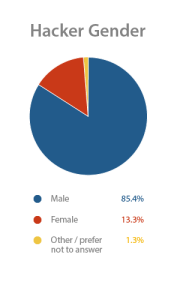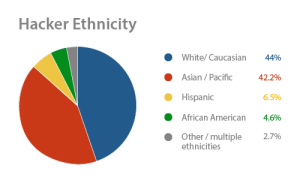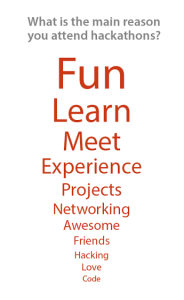Hackathons are filling a void for students who want to learn new skills and meet their peers, Major League Hacking found in its recent survey.
Coding contests have reached a critical mass in the past two years. Hackathons are now popular through the United States and are rapidly spreading to other countries, stimulating a cross-pollination of ideas that is changing the way students learn and collaborate.
The MLH survey reached 920 student hackers with 80 percent between ages 18-22.
The results showed just how powerful hackathons can be. Eighty-five percent said they’d like to participate in another hackathon, 69 percent said they continued working on their projects after the hackathon ended, and 20 percent said their major is something other than computer science or computer/electrical/software engineering.
Unfortunately, 52 percent said their school doesn’t have a hacking club or they do not participate in it. Other than simply being busy or having travel limitations, those who didn’t make it to a hackathon cited not having a team, not knowing anyone else at the events, or just not feeling prepared.
But for those who do participate, the connections they make remain even after the events conclude. Student hackers from around the world collaborate on ideas and discuss current technology issues on social media platforms. Questions such as, “Has anyone used ______ to do ______ with ______ for a shipped project?” are posted daily in the “Hackathon Hackers” Facebook group with more than 3,000 members.
For both beginners and experienced developers, hackathons often act as a catalyst, giving them exposure to opportunities to make an impact through code and technology. For example, Vishnu Ravi, of Albany Medical College, started coding when he was nine, but stopped hacking during medical school. Feeling his skills were getting stale, he signed up for his first hackathon and won. He founded a startup with his hackathon friends and began teaching other doctors how to code. Now, senior trauma and brain surgeons seek him out and ask him about his work.
 While hackathons are providing community and professional support to thousands, the MLH survey also revealed that some groups are underrepresented at these events. Only 13 percent of respondents are female. White and Asian participants made up 86 percent, with less than 14 percent being African American, Hispanic, or Native American combined. The results mirror minority underrepresentation in undergraduate programs across the United States.
While hackathons are providing community and professional support to thousands, the MLH survey also revealed that some groups are underrepresented at these events. Only 13 percent of respondents are female. White and Asian participants made up 86 percent, with less than 14 percent being African American, Hispanic, or Native American combined. The results mirror minority underrepresentation in undergraduate programs across the United States.
Hackathons are for everyone
 Technology executives know that workforce diversity will help them make better products. However, their hands are somewhat tied because the gap begins in the computer science education pipeline. Hackathons are situated on the front line of this issue, acting as a gateway into the awe-inspiring world of technology.
Technology executives know that workforce diversity will help them make better products. However, their hands are somewhat tied because the gap begins in the computer science education pipeline. Hackathons are situated on the front line of this issue, acting as a gateway into the awe-inspiring world of technology.
“Taking part in hackathons made me more confident in my skills, especially when I saw what I could contribute in 24 hours and how other people perceived [my team’s] work,” said a University of Washington hacker. “I met a lot of females who seem pretty comfortable in their own skin, and that’s definitely made me more comfortable in the industry.”
How can we disrupt the gender and ethnicity gap?
Hackers are known for seeing a problem, turning it on its head, and fixing it. So what can be done within the hackathon community to engage more people?
- Invite them.
- Talk to people in person. Make sure they know what a hackathon is and that it is not just coding alone all night.
- Emphasize that hackathons are for beginners too. Many hackathons are including workshops and resources for people who have never coded before.
- Minimize bragging. Hackathons are about making things that will change the world, not proving that you are the biggest and baddest hacker. Overly competitive language can be very intimidating for those who already feel underprepared.
And the winner of Oculus Rift is…
Trushitha Narla , an incoming Brown University freshman, was randomly selected among survey respondents as the winner of an Oculus Rift. Narla suggested a 3-D point-and-click adventure game, in the form of an interactive comic book, where the user is the heroine. One of her ideas for Rift projects is a 3D point-and-click adventure game, in the form of an interactive comic book, where the user is the superhero. She is also interested in integrating the Leap Motion gesture controller into the Occulus headset.
, an incoming Brown University freshman, was randomly selected among survey respondents as the winner of an Oculus Rift. Narla suggested a 3-D point-and-click adventure game, in the form of an interactive comic book, where the user is the heroine. One of her ideas for Rift projects is a 3D point-and-click adventure game, in the form of an interactive comic book, where the user is the superhero. She is also interested in integrating the Leap Motion gesture controller into the Occulus headset.
Narla, of Northside College Preparatory High School in Chicago, said she hopes to join the Hack@Brown organizing committee. In her spare time, she’s working on a 2-D infinite runner game called Sprout.

[…] June, we came out with the Hacker Survey, the first large scale survey of our community. From it we learned a lot about our community and continue to use the data to improve it and provide awesome resources for […]
[…] We often talk about this community as a grand, philosophically uniting group. But at this writing, this community is overwhelmingly composed of self-identifying heterosexual white and Asian males. This state of affairs is evident if you attend one of these events, and if you view our 2014 Hacker Survey. […]